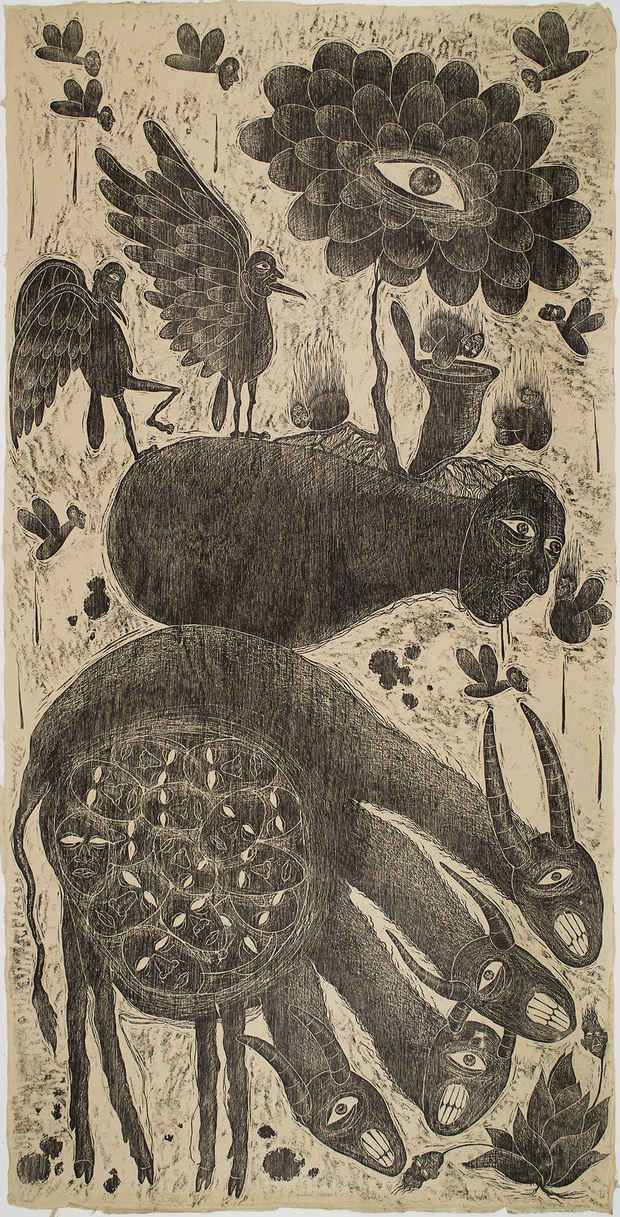“Immortal Menagerie” Exhibition
Cavin-Morris Gallery

[Image: Kriangkrai Kongkhanun]
This event has ended.
Cavin-Morris Gallery presents a special group exhibition: Immortal Menagerie, independently curated by Cavin-Morris staff members Marissa Levien and Caroline Casey.
Immortal Menagerie is an international mythological zoological display mixing self-taught artists, contemporary artists, and ethnographic works. Depictions of animals have many spiritual and cultural connotations for both artist and observer. For this exhibition, we focused on works that evoke a sense of the artists’ cultural background, and most importantly, their spirituality. Even when the artists are unknown, as is the case with the international selection of masks, we focused on pieces that possess mythic symbology relating back to their cultures of origin. The creatures displayed are both literal or imaginary— sometimes they are deities, sometimes demons, sometimes harbingers, and sometimes escorts shepherding us to another plane.
Thai contemporary artist Kriangkrai Kongkhanun conjures beasts that depict a Buddhist version of Hell. He allows this Buddhist form of the spirit world to be complicated by the Western artistic styles and spiritual philosophies he absorbed while studying in Florence. Indonesian artist Angkaspura also allows folklore and religion to seep into his mind as he draws with a sort of cultural free association. His daily prayers are distilled into these drawings of otherwordly beings, pulling influence from Balinese illustrations, Javanese scrolls, Papuan imagery, and the daily sensory barrage of Jakarta.
For artists like Amalia, the recently deceased Seri storyteller and shamaness, animal depictions are a proud, surviving custom of her people, a tribe living in Sonoran Mexico. The tradition of the Seri is to carve shapes of animals out of wood— Amalia was the first to also draw these holy creatures on paper. Aboriginal artist Bobby Ngainmijra also hews closely to the customs of his people, and shares Amalia’s humility towards the natural world— in his drawings he allows animals’ souls to intermingle on equal footing with human souls. His work observes the brutal, cyclical force of nature, with various spirits dominating and eating one another in turn.
In more irreverent ways, the Fante people of West Africa hew closely to traditional symbols from their proverbs and stitch them into the flags they proudly display. The asafo companies constantly reshape the monsters and creatures of local stories to their own ends, turning them into taunts and insults for rival military clans, and creating a new, ever-changing folkloric lexicon in the process.
Animals can serve as orisons of memory in addition to myth. Franck Lundangi immigrated from Africa to France when he was 32 and the works he paints now, he says, are dreams of the Africa he left behind, possibly one that never existed at all. Christine Sefolosha lived in South Africa and worked with animals for a significant period of her life before returning to her native Switzerland. The animals of Africa, and the haunting aura and energy the place still flows through her work oneirically, even now. Instead of dreams or memories, there’s a nightmare to the life of Czech artist Karel Havlíček that speaks of imagination unfulfilled. The beings in his drawings have absorbed the spirit of a man whose defiant work was subdued and devoured by totalitarian government.
Through such beings, these artists encapsulate the strength and harshness of the natural world, and of a more interior, intangible world. Each mammal, insect, fish, bird, and imaginary beast can be seen as a fragmentary cultural collage; they are pieced together with religion, folklore, memory, body, and spirit.
Media
Schedule
from March 02, 2017 to April 08, 2017
Opening Reception on 2017-03-02 from 18:00 to 20:00